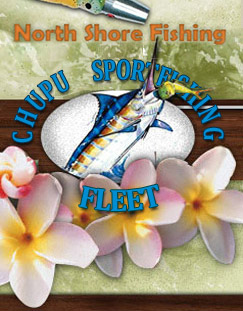Oahu Weather conditions
While the weather in Hawaii remains pretty constant almost year round there are a few difference from season to season. Spring and summer are generally dryer which doesn’t really effect the fishing but can make for more hot sunny days during your visit. Your outdoor activities usually are not hampered by rain during the summer months. High pressure weather systems around the state cause typical trade winds blow out of the east the majority of the time and keeps the temperature in the high 80’s. Fall and Winter on Oahu’s North Shore is “Big Surf” season. This is when the town of Haleiwa and the whole north coast of the island comes alive with people flocking to be a part of the surf culture. Rain is more often included in the forecast at this time of year. Add a light jacket to your bag before heading off for most outdoor activities .
More low pressure systems will move into our area during this time of year causing a break in the winds. With less wind the choppy inshore and offshore waters can get slick flat. Great conditions for all ocean activities but things can get quite muggy on land when the trade winds quit blowing. No wind also results in our equivalent of SMOG. In Hawaii we call it VOG because not only is the air clouded with industrial and automotive fallout but the ash from the ever erupting volcanoes on the big island add to the smog like conditions. With out the normal wind to blow all that junk out to sea it just hangs over the islands creating a very hazy condition.
Oahu Sea Conditions
A typical day on the north and east side of any of the Hawaiian islands is 15-20mph breeze from the east and an 4’ sea with some chop thrown in to make it interesting. Since the water is so deep offshore the large winter surf does not affect the sea conditions offshore in the fishing grounds. What makes the boat move around is the wind and the sea and chop generated by it blowing across thousands of miles of ocean before reaching hawaii. When a low pressure weather system moves in and cuts off the trade winds, we enjoy slick flat calm conditions for as long and that weather pattern is on place.A short run to the west and around the corner of the island puts on the leeward side of the island. Fishing behind the island and out of the path of the wind usually results in much calmer seas and a smoother ride for people looking for more comfort. In the case of extreme or unsafe weather conditions per the US Coast Guard and NOAA weather reports (not TV news) our Captains will make the call to stay at dock. Your confirmation email includes a message with your Captain’s name and phone number and you are asked to call the Captain the day before your charter to check in and for a weather update. If the call is made to stay at dock you can either reschedule your fishing trip or be refunded your deposit.
Oahu Temperatures
Year round temperature are typical in the high 70’s in the mornings and mid/high 80’s by noon. Fall and winter mornings can be cool with a handful of days in the upper 60’s. As soon as the sun is over the mountains it warms up quickly. Any weather patterns that influence the fishing: (ex. Sail fishing normally kicks off with the first winter cold front.) As a general rule the chopper the water the better the Mahi Mahi and Ahi fishing seems to be. This is one of the reasons that we enjoy such good fishing on the North Shore. Typically is isn’t flat. The trade winds work in conjunction with ocean currents in our area which can blow floating debris into our fishing grounds. Finding something that has been floating in the sea for months or even years and collecting bait and game fish underneath it can be some of the best fishing you will ever see. On the other side of the coin when a low pressure system moves in and the seas get calm. The Ono fishing really heats up. A slick flat day with a good tidal current is optimum for epic Ono fishing on the ledges and drop-offs on the north shore. And for fishing for Monster Blue Marlin the calmer days seem to raise more large Marlin offshore.
For all our trips
Bring your food and beverages for the day (but PLEASE leave your bananas at home as they are considered BAD LUCK!!)
Sunglasses, hat and sunscreen (Hawaii sun is intense)
Light windbreaker (layering is best!)
Camera or video equipment
Motion sickness medication. Please consult your doctor or pharmacist for recommendations



